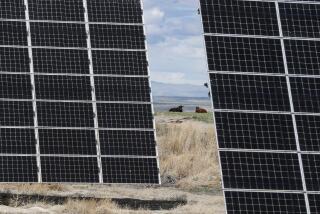Speaking of: : Renewable Energy
- Share via
Just decades ago, with oil, coal and hydroelectric power lighting the world and driving its industries, alternate sources were dismissed by critics as utopian “wood chips and windmills.”
Since then, alternatives, most lumped under the category of renewable energy, have benefited from an infusion of technology, the faith of investors and the increasing expense of conventional fuels. In particular, solar and wind-generated energy are popular because they generate electricity cleanly, quietly and relatively inexpensively.
Worldwide solar research and funding have doubled since 1990. Shipments of photovoltaic cells, which convert the sun’s rays to electricity, have increased an average of 11% annually over the last decade, despite high manufacturing costs. According to some forecasts, the number of installed solar-energy units in the United States will quadruple to nearly 5 million by 2010.
Use of wind power to drive turbines and generate electricity, has also increased after a brief decline earlier in this decade. Several major projects are slated in Texas, Wyoming, and especially California, which along with Denmark operates 90% of the world’s wind turbines. As with solar energy, operating expenses for wind systems are virtually nil after start-up.
The big industrial nations lead the world in conventional-power usage and also set the pace in renewable power, which is defined by the National Renewable Energy Lab as any source that can be used continuously without depletion--including solar, wind, hydroelecftric and geothermal energy.
WIND POWER
TURBINE SYSTEM
(1) The wind flows past airfoil-type blade, causing them to rotate and turn the shaft. The transmission maintains a constant speed in the shaft entering the generator, which produces electricity.
(2) The turbine assembly pivots to keep facing the wind as it changes direction. A wind turbine can stand alone or be installed with others to provide power.
Wind energy was first used in 7th-Century Persia when windmills used sails to develop power. Today, turbines employ advanced technology to increase efficiency.
(World wind energy gnerating capacity)
SOLAR POWER
CENTRAL RECEIVER SYSTEM
1) Computer-controlled concave mirrors called heliostats are arrayed in a circular pattern around a tower.
2) The mirrors reflect the sun’s rays to a cylindrical receiver, a 46-foot-high steam boiler atop the tower.
3) Water pumped to the receiver core is superheated into steam, which is piped to a turbine-generator below the tower’s base. (Path A)
4) The steam can either go directly to the turbine-generator (Path A) to produce electric power for immediate use, or be pumped to a storage tank (Path B), where it heats stored oil for future use.
The United States and France lead the world in this type of power generation, in which a single, massive unit can supply thousands of users. Four other countries have smaller-scale projects under way.
(World photovotaic shipments) SOLAR-GENERATED ELECTRICITY
Solar-energy systems rely on panels of photovoltaic cells, each typically 3 inches wide and layered with silicon. They are coated with either boron (for a negative charge) or phosphorus (positive charge). When sunlight strikes a cell, electrons are discharged, creating a direct current (DC). This electricity is then converted to alternating current (AC), which can be stored in automobile-type batteries overnite or for use on overcast days. Photovoltaic cells were originally created for space vehicles such as the Skylab satellite.
SOLAR-GENERATED HEAT: TWO SYSTEMS
ACTIVE
(1) Sun heats water or other liquid in channels in roof-mounted collector.
(2) The heated liquid in the collectors flows down into a storage tank where its heat is transferred to water by a heat exchanger inside the tank.
(3) Pump A moves the water to another heat exchanger, which heats the air blown into the house.
(4) Pump B returns the cooled liquid to the collectors to be reheated.
PASSIVE
(1) Solar air heater, called a thermosyphon, absorbs sun’s rays. A layer of glass covering the air heater traps heat-producing infrared rays.
(2) Hot air rises until it passes a rock-storage bed. The rocks extract heat from the air, which descends as it cools.
(3) The cycle continues as air filters through the bottom of the rock bed and back through an inlet toward the solar heater.
(4) During the evening or colder hours, a damper can be opened to release heat from the storage bin.
Compiled by Times researcher JOHN MALNIC
More to Read
Inside the business of entertainment
The Wide Shot brings you news, analysis and insights on everything from streaming wars to production — and what it all means for the future.
You may occasionally receive promotional content from the Los Angeles Times.










